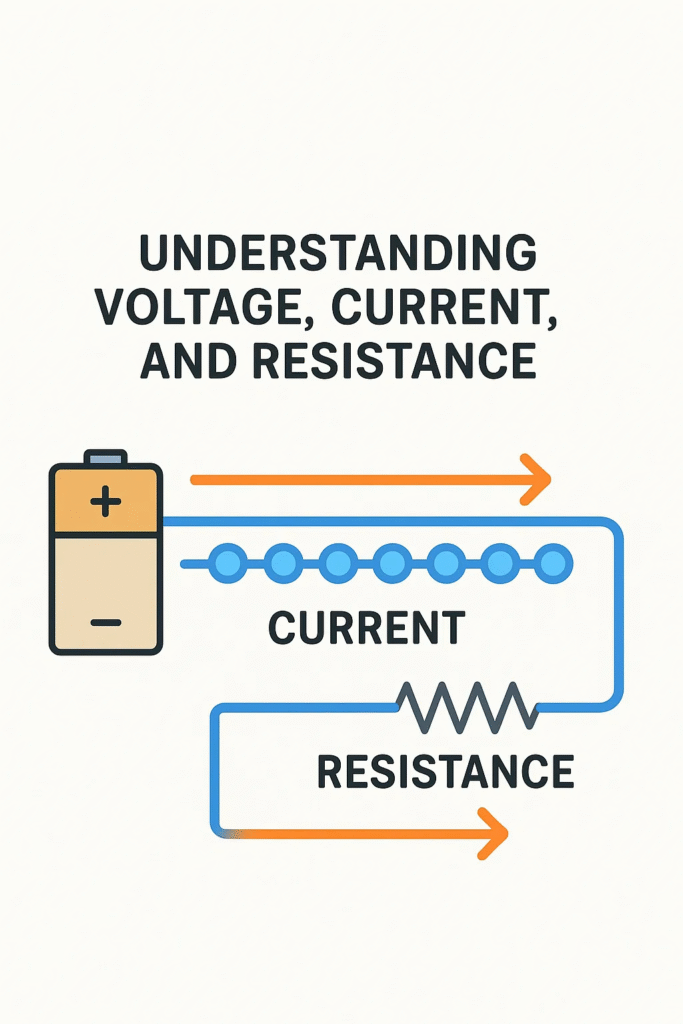Understanding Voltage, Current, and Resistance Like a Human Being
Electricity is one of those things we all rely on constantly but rarely stop to think about. You flip a switch, and the light comes on. You plug in your charger, and your phone starts filling up with power. It’s everyday magic… or so it seems. But behind that magic are a few simple principles—voltage, current, and resistance.
Even if you didn’t exactly fall in love with physics in school, you’ve probably heard these terms. Maybe you nodded along in conversation, hoping no one would ask you to explain them. Well, you’re not alone. Let’s clear the fog together and get a solid grasp on what these things actually mean—no science degree required.
🌟 What Is Voltage, Anyway?
Let’s start with voltage because this is where all the action begins.
Imagine electricity as water flowing through a pipe. Voltage is like the pressure that pushes the water through. No pressure? No flow. It’s the same with electrons—the tiny particles that make up electricity. Voltage is the force that encourages them to start moving.
In technical terms, voltage is the electric potential difference between two points. But let’s skip the textbook and keep it real.
You’ve got a fully charged phone and one that’s nearly dead. If you connect them directly (please don’t), electrons would naturally want to move from the full battery to the empty one—because there’s a difference in “electric pressure.” That’s voltage in action.
The higher the voltage, the stronger the push. It’s why power lines carry electricity at such high voltages—it helps the electricity travel long distances without losing steam.
💡 Then Comes Current: The Actual Flow of Electricity
If voltage is the push, current is the actual movement of the electrons. It’s what you’re really using when you turn on the TV, charge your phone, or boil water in your kettle.
In more human terms: voltage is saying “Go!”, and current is the electrons responding, “Alright, we’re going!”
Current is measured in amperes, or amps for short. It tells you how much electricity is actually flowing at a given time.
🧵 Think of This:
Going back to our water analogy, current would be the amount of water flowing through the hose. A trickle is low current. A gushing stream is high current. Simple.
You might have heard people say, “It’s not the voltage that kills, it’s the current.” And it’s true: you can have high voltage and still be safe if there’s no current flowing. But even a low-voltage situation can be dangerous if the current is high enough.
⚙️ Resistance: The Flow-Slowing Factor
So we’ve got the push (voltage) and the flow (current). Now enter resistance—the thing that pushes back. It resists, slows down, or limits how much current can move.
Everything that electricity flows through offers some resistance, even copper wires. Materials like rubber or glass have high resistance and don’t let electricity flow easily—that’s why they’re used as insulators.
Resistance is measured in ohms, and you’ll often see the symbol Ω used to represent it.
🧱 A Quick Analogy:
Let’s say you’re trying to water your garden. If you use a wide hose, the water flows easily. That’s low resistance. But if the hose is narrow or clogged, the water struggles to get through. That’s high resistance.
The same applies to electric current. The thinner or longer the wire, the more resistance it offers. Devices like heaters actually use materials with intentionally high resistance—because when electricity struggles to pass through, it generates heat. That heat warms your room or boils your water. Pretty clever, right?
🔁 Ohm’s Law: Where It All Comes Together
Now, this is where we see how these three guys—voltage, current, and resistance—work hand in hand. Enter the star of the show: Ohm’s Law.
It’s a super simple equation:
[ V = I \times R ]
Where:
- V is voltage (volts)
- I is current (amps)
- R is resistance (ohms)
This equation means that if you know any two of the three values, you can find the third.
Let’s make it super practical:
Example:
Imagine you have a small circuit with a 9-volt battery and a resistor of 3 ohms. Using Ohm’s Law:
[ I = \frac{V}{R} = \frac{9}{3} = 3 \text{ amps} ]
Now you know how much current will flow through that circuit. Electricians use this kind of math every day to figure out how safe and efficient a circuit is.
🛠 Seeing It in Everyday Life
Here’s the thing—this isn’t just science for the sake of science. These concepts pop up in your everyday life more often than you think.
📱 Phone Chargers
Your charger probably says something like “5V – 2A.” That means it supplies 5 volts and can push up to 2 amps of current. If your phone needs more power, it’ll pull more current—but only if the charger can handle it. Otherwise, it charges more slowly.
⚡ Circuit Breakers
Your home’s breaker panel uses the idea of current limits to protect against overload. If something draws too much current, the breaker trips and shuts it off. That’s a good thing—it prevents overheating and possible fires.
🔥 Electric Heaters
Heaters and toasters use materials with high resistance so that when electricity passes through, it heats up. That resistance is doing all the work—slowing down the current just enough to turn it into warmth.
💡 LED Bulbs
Modern LED lights are energy-efficient because they use much less current for the same voltage. Lower current, less heat, longer-lasting bulbs.
🤯 Why It All Matters (Even If You’re Not an Engineer)
Look—we’re not saying you need to memorize Ohm’s Law or start rewiring your house. But the beauty of understanding voltage, current, and resistance is that it empowers you to make smarter decisions.
You’ll know why certain cables charge faster than others. You’ll understand why your circuit trips when you plug in too many appliances. You’ll stop being intimidated by the tech specs printed on your electronics.
And if something ever goes wrong—like a charger burning out or lights flickering—this basic knowledge could save you time, money, and even keep you safe.
🌱 Want to Learn More?
If you found this interesting (and I hope you did), there’s a whole world of simple electrical concepts to explore:
- AC vs. DC: What’s the difference?
- How batteries actually work
- What are circuits, and what’s the deal with series vs. parallel?
- What’s inside a fuse?
- Capacitors, inductors, and all that jazz
Electricity isn’t just science—it’s part of life. And now, you’ve got the foundation to understand it better than most.

